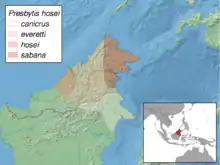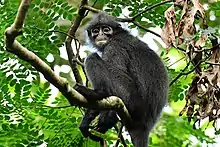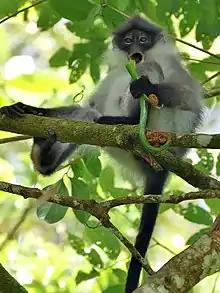Surili
The surilis are a group of Old World monkeys in the genus Presbytis. They live in the Thai-Malay Peninsula, on Sumatra, Borneo, Java and smaller nearby islands.[1] Besides surili, the common names for the monkeys in the genus also often use the terms "langur" or "leaf monkey."
| Surili[1] | |
|---|---|
 | |
| Javan surili | |
| Scientific classification | |
| Domain: | Eukaryota |
| Kingdom: | Animalia |
| Phylum: | Chordata |
| Class: | Mammalia |
| Order: | Primates |
| Suborder: | Haplorhini |
| Infraorder: | Simiiformes |
| Family: | Cercopithecidae |
| Subfamily: | Colobinae |
| Tribe: | Presbytini |
| Genus: | Presbytis Eschscholtz, 1821 |
| Type species | |
| Presbytis mitrata | |
| Species | |
|
11, see text | |
Description
Surilis are rather small, slimly built primates. Their fur at the top is brown, grey, black, or orange, and at the lower surface whitish or greyish, sometimes also orange, with some species having fur designs at the head or at the hips.[2][3] Their German name of Mützenlanguren ("capped langurs") comes from the hair on their head, which forms a tuft. They differ from the other langurs by characteristics in the shape of their head (particularly the poorly developed or absent brow ridges, and the prominent nasal bones),[2] in the teeth, and by the size of their small thumbs. Surilis range in adult length from 40 to 60 cm (with a 50- to 85-cm-long tail) and a weight of 5 to 8 kg.[2]
Behaviour
Diurnal forest dwellers, they spend nearly their entire lives in the trees. They live in groups of up to 21 animals (typically 10 or fewer animals in most species) consisting of a male, several females, and their young.[3] A few species have been observed in monogamous pairings (particularly the Mentawai langur),[3] although this might be a reaction to the decrease of their habitat. Lone males and all-male groups have also been reported.[2] The groups are hierarchically developed, with intergroup communication that is both vocal and postural.
Diet
The surilis' diet consists of leaves, fruits, and seeds.[3]
Breeding
Gestation time is 5–6 months, and births are typically of single young. Newborn animals are white colored and have a black strip at the back, although some have a cross-shaped mark. By one year old, the young are weaned and at an age of 4–5 years, they are fully mature. The typical life expectancy in the wild remains poorly known for most species, but captive Sumatran surilis have lived more than 18 years.[2]
Conservation
Several species in this genus are restricted to regions with extensive habitat destruction, and are also threatened by hunting. Consequently, 16 of the 19 species are rated as vulnerable or worse by IUCN,[4] and the Sarawak surili has been referred to as "one of the rarest primates in the world."[5] Recently, a subspecies of Hose's langur called Miller's grizzled langur, thought to be extinct, was rediscovered in the Wehea Forest on the eastern tip of Borneo island,[6] though it remains one of the world's most endangered primates.[7]
Taxonomy
Two other genera, Trachypithecus and Semnopithecus, were formerly considered subgenera of Presbytis.[1] The species-level taxonomy of Presbytis is complex, and significant changes have been proposed for several in recent years.[1][8][9][10]
| Common name | Scientific name and subspecies | Range | Size and ecology | IUCN status and estimated population |
|---|---|---|---|---|
| Black Sumatran langur | P. sumatranus (S. Müller, Schlegel, 1841) |
Island of Sumatra in Indonesia | Size: 42–61 cm (17–24 in) long, plus 50–85 cm (20–33 in) tail[11] Habitat: Forest[12] Diet: Fruit, leaves, seeds and flowers[12] |
EN
|
| Black-and-white langur | P. bicolor Aimi, Bakar, 1992 |
Island of Sumatra | Size: 42–61 cm (17–24 in) long, plus 50–85 cm (20–33 in) tail[11] Habitat: Forest[13] Diet: Fruit, seeds, and leaves[11] |
DD
|
| Black-crested Sumatran langur
|
P. melalophos (Raffles, 1821) |
Island of Sumatra |
Size: 42–61 cm (17–24 in) long, plus 50–85 cm (20–33 in) tail[11] Habitat: Forest and shrubland[14] Diet: Fruits and leaves, as well as seeds and flowers[15] |
EN
|
| East Sumatran banded langur | P. percura Lyon, 1908 |
Island of Sumatra | Size: 42–61 cm (17–24 in) long, plus 50–85 cm (20–33 in) tail[11] Habitat: Forest[16] Diet: Fruit, seeds, and leaves[11] |
CR
|
| Hose's langur
|
P. hosei (Thomas, 1889) |
Borneo |
Size: 42–61 cm (17–24 in) long, plus 50–85 cm (20–33 in) tail[11] Habitat: Forest[17] Diet: Leaves, unripe fruits, seeds, flowers, bird eggs and nestlings[17] |
VU
|
| Javan surili
|
P. comata (Desmarest, 1822) Two subspecies
|
Island of Java in Indonesia |
Size: 42–61 cm (17–24 in) long, plus 50–85 cm (20–33 in) tail[11] Habitat: Forest[18] Diet: Leaves, as well as fruits, flowers, and seeds[18] |
VU
|
| Maroon leaf monkey
|
P. rubicunda (Müller, 1838) Five subspecies
|
Borneo |
Size: 42–61 cm (17–24 in) long, plus 50–85 cm (20–33 in) tail[11] Habitat: Forest and inland wetlands[19] Diet: Leaves, seeds, and fruit, as well as flowers and pith[19] |
VU
|
| Siberut langur
|
P. siberu (Chasen, Kloss, 1928) |
Island of Siberut in Indonesia |
Size: 42–61 cm (17–24 in) long, plus 50–85 cm (20–33 in) tail[11] Habitat: Forest[20] Diet: Fruit, seeds, and leaves[11] |
EN
|
| Mentawai langur | P. potenziani (Bonaparte, 1856) |
Mentawai islands in Indonesia |
Size: 42–61 cm (17–24 in) long, plus 50–85 cm (20–33 in) tail[11] Habitat: Forest[21] Diet: Fruit, seeds, and leaves[11] |
CR
|
| Miller's langur
|
P. canicrus G. S. Miller, 1934 |
Eastern Borneo (in light green) |
Size: 42–61 cm (17–24 in) long, plus 50–85 cm (20–33 in) tail[11] Habitat: Forest[22] Diet: Fruit, seeds, and leaves[11] |
EN
|
| Mitered langur | P. mitrata Eschscholtz, 1821 |
Island of Sumatra | Size: 42–61 cm (17–24 in) long, plus 50–85 cm (20–33 in) tail[11] Habitat: Forest[23] Diet: Fruit, seeds, and leaves[11] |
VU
|
| Natuna Island surili | P. natunae (Thomas, Hartert, 1894) |
Island of Natuna Besar in Indonesia |
Size: 42–61 cm (17–24 in) long, plus 50–85 cm (20–33 in) tail[11] Habitat: Forest[24] Diet: Fruit, seeds, and leaves[11] |
VU
|
| Raffles' banded langur
|
P. femoralis (Martin, 1838) |
Singapore and southern Peninsular Malaysia |
Size: 42–61 cm (17–24 in) long, plus 50–85 cm (20–33 in) tail[11] Habitat: Forest[25] Diet: Fruit, seeds, and leaves[11] |
CR
|
| Robinson's banded langur
|
P. robinsoni Thomas, 1910 |
Southern Malay Peninsula |
Size: 42–61 cm (17–24 in) long, plus 50–85 cm (20–33 in) tail[11] Habitat: Forest[26] Diet: Fruit, seeds, and leaves[11] |
NT
|
| Sabah grizzled langur | P. sabana (Thomas, 1893) |
Eastern Borneo (in dark brown) |
Size: 42–61 cm (17–24 in) long, plus 50–85 cm (20–33 in) tail[11] Habitat: Forest[27] Diet: Fruit, seeds, and leaves[11] |
EN
|
| Sarawak surili
|
P. chrysomelas (Müller, 1838) Two subspecies
|
Northern Borneo |
Size: 42–61 cm (17–24 in) long, plus 50–85 cm (20–33 in) tail[11] Habitat: Forest[5] Diet: Fruit, seeds, and leaves[11] |
CR
|
| Thomas's langur
|
P. thomasi (Collett, 1893) |
Northern island of Sumatra in Indonesia |
Size: 42–62 cm (17–24 in) long, plus 50–85 cm (20–33 in) tail[28] Habitat: Forest[29] Diet: Fruit, leaves, and seeds, as well as flowers, bark, twigs, stalks, birds, bird eggs, algae, and insects[28] |
VU
|
| White-fronted surili
|
P. frontata (Müller, 1838) |
Borneo |
Size: 42–61 cm (17–24 in) long, plus 50–85 cm (20–33 in) tail[11] Habitat: Forest[30] Diet: Fruit, seeds, and leaves[11] |
VU
|
| White-thighed surili
|
P. siamensis (Müller, Schlegel, 1838) Four subspecies
|
Southeastern Asia |
Size: 42–61 cm (17–24 in) long, plus 50–85 cm (20–33 in) tail[11] Habitat: Forest[31] Diet: Fruit, seeds, and leaves[11] |
NT
|
References
- Groves, C. P. (2005). Wilson, D. E.; Reeder, D. M. (eds.). Mammal Species of the World: A Taxonomic and Geographic Reference (3rd ed.). Baltimore: Johns Hopkins University Press. pp. 170–172. ISBN 0-801-88221-4. OCLC 62265494.
- Novak, R. M. (1999). Walker's Mammals of the World. 6th edition. Johns Hopkins University Press, Baltimore. ISBN 0-8018-5789-9
- Rowe, N. (1996). The Pictorial Guide to the Living Primates. Pogonias Press, Rhode Island. ISBN 0-9648825-0-7
- IUCN (2008). 2008 IUCN Red List of Threatened Species. Retrieved on 2008-12-15.
- Nijman, V.; Cheyne, S.; Traeholt, C.; Setiawan, A. (2020). "Presbytis chrysomelas". IUCN Red List of Threatened Species. 2020: e.T39803A17955321. doi:10.2305/IUCN.UK.2020-2.RLTS.T39803A17955321.en.
- The Guardian, guardian.co.uk, Friday 20 January 2012: 'Extinct' monkey rediscovered in Indonesia jungle.
- "'Extinct' monkey still lives in Borneo". CBC News.
- Meyer, Dirk; Rinaldi, Ir. Dones; Ramlee, Hatta; Perwitasari-Farajallah, Dyah; Hodges, Keith; Roos, Christian (2011). "Mitochondrial phylogeny of leaf monkeys (genus Presbytis, Eschscholtz, 1821) with implications for taxonomy and conservation". Molecular Phylogenetics and Evolution. 59 (2): 311–319. doi:10.1016/j.ympev.2011.02.015. PMID 21333742. Retrieved 2020-04-08.
- Ang, A.; Roesma, D.I.; Nijman, V.; Meier, R.; Srivathsan, A. & Rizaldi (2020). "Faecal DNA to the rescue: Shotgun sequencing of non-invasive samples reveals two subspecies of Southeast Asian primates to be Critically Endangered Species". Scientific Reports. 10 (1): 9396. Bibcode:2020NatSR..10.9396A. doi:10.1038/s41598-020-66007-8. PMC 7287133. PMID 32523128.
- Abdul-Latiff MAB; Baharuddin H; Abdul-Patah P; Md-Zain BM (2019). "Is Malaysia's banded langur, Presbytis femoralis femoralis, actually Presbytis neglectus neglectus? Taxonomic revision with new insights on the radiation history of the Presbytis species group in Southeast Asia" (PDF). Primates. 60 (1): 63–79. doi:10.1007/s10329-018-0699-y. PMID 30471014. S2CID 254160597.
- Nowak 1999, pp. 599–600
- Traeholt, C.; Setiawan, A. (2020). "Presbytis sumatranus". IUCN Red List of Threatened Species. 2020: e.T136912A17986913. doi:10.2305/IUCN.UK.2020-2.RLTS.T136912A17986913.en.
- Nijman, V. (2021). "Presbytis bicolor". IUCN Red List of Threatened Species. 2021: e.T39812A206547286. doi:10.2305/IUCN.UK.2021-3.RLTS.T39812A206547286.en.
- Nijman, V.; Setiawan, A.; Traeholt, C.; Manullang, B. (2020). "Presbytis melalophos". IUCN Red List of Threatened Species. 2020: e.T39811A17954271. doi:10.2305/IUCN.UK.2020-2.RLTS.T39811A17954271.en.
- Tedesco, Dana (2006). "Presbytis melalophos". Animal Diversity Web. University of Michigan. Archived from the original on August 12, 2023. Retrieved July 24, 2023.
- Rizaldi, Ang; A., Kurnia; I., Prasetio; I., Nijman; V., Setiawan; A., Boonratana; R. (2021). "Presbytis percura". IUCN Red List of Threatened Species. 2021: e.T39805A205841390. doi:10.2305/IUCN.UK.2021-3.RLTS.T39805A205841390.en.
- Nijman, V.; Traeholt, C.; Setiawan, A.; Cheyne, S. (2021) [amended version of 2020 assessment]. "Presbytis hosei". IUCN Red List of Threatened Species. 2021: e.T175648870A195370322. doi:10.2305/IUCN.UK.2021-1.RLTS.T175648870A195370322.en.
- Nijman, V.; Setiawan, A.; Ang, A. (2022). "Presbytis comata". IUCN Red List of Threatened Species. 2022: e.T210369485A210370097. doi:10.2305/IUCN.UK.2022-1.RLTS.T210369485A210370097.en.
- Cheyne, S.; Ehlers-Smith, D. A.; Nijman, V.; Traeholt, C. (2020). "Presbytis rubicunda". IUCN Red List of Threatened Species. 2020: e.T18131A17953935. doi:10.2305/IUCN.UK.2020-2.RLTS.T18131A17953935.en.
- Quinten, M; Setiawan, A.; Traeholt, C.; Cheyne, S. M.; Whittaker, D. (2020). "Presbytis siberu". IUCN Red List of Threatened Species. 2020: e.T39816A17986963. doi:10.2305/IUCN.UK.2020-2.RLTS.T39816A17986963.en.
- Setiawan, A.; Quinten, M; Cheyne, S.; Traeholt, C.; Whittaker, D. (2020). "Presbytis potenziani". IUCN Red List of Threatened Species. 2020: e.T39815A17954456. doi:10.2305/IUCN.UK.2020-2.RLTS.T39815A17954456.en.
- Cheyne, S.; Setiawan, A.; Traeholt, C. (2021) [amended version of 2021 assessment]. "Presbytis canicrus". IUCN Red List of Threatened Species. 2021: e.T39808A200247353. doi:10.2305/IUCN.UK.2021-2.RLTS.T39808A200247353.en.
- Nijman, V.; Setiawan, A.; Traeholt, C.; Manullang, B. (2020). "Presbytis mitrata". IUCN Red List of Threatened Species. 2020: e.T39813A17986718. doi:10.2305/IUCN.UK.2020-2.RLTS.T39813A17986718.en.
- Setiawan, A.; Cheyne, S.; Traeholt, C. (2020). "Presbytis natunae". IUCN Red List of Threatened Species. 2020: e.T136500A17955492. doi:10.2305/IUCN.UK.2020-2.RLTS.T136500A17955492.en.
- Ang, A.; Boonratana, R.; Nijman, V. (2022). "Presbytis femoralis". IUCN Red List of Threatened Species. 2022: e.T39801A215090780. doi:10.2305/IUCN.UK.2022-1.RLTS.T39801A215090780.en.
- Ang, A.; Boonratana, R.; Nijman, V. (2021). "Presbytis robinsoni". IUCN Red List of Threatened Species. 2021: e.T39806A205875703. doi:10.2305/IUCN.UK.2021-3.RLTS.T39806A205875703.en.
- Setiawan, A.; Traeholt, C. (2020). "Presbytis sabana". IUCN Red List of Threatened Species. 2020: e.T39810A17987041. doi:10.2305/IUCN.UK.2020-2.RLTS.T39810A17987041.en.
- Matthews, Mika (2004). "Presbytis thomasi". Animal Diversity Web. University of Michigan. Archived from the original on August 12, 2023. Retrieved July 24, 2023.
- Setiawan, A.; Traeholt, C. (2020). "Presbytis thomasi". IUCN Red List of Threatened Species. 2020: e.T18132A17954139. doi:10.2305/IUCN.UK.2020-2.RLTS.T18132A17954139.en.
- Cheyne, S.; Traeholt, C.; Setiawan, A.; Nijman, V.; Meijaard, E. (2020). "Presbytis frontata". IUCN Red List of Threatened Species. 2020: e.T18127A17954836. doi:10.2305/IUCN.UK.2020-2.RLTS.T18127A17954836.en.
- Ang, A.; Traeholt, C. (2020). "Presbytis siamensis". IUCN Red List of Threatened Species. 2020: e.T18134A17953755. doi:10.2305/IUCN.UK.2020-2.RLTS.T18134A17953755.en.
Sources
- Nowak, Ronald M. (1999). Walker's Mammals of the World. Vol. 1. Johns Hopkins University Press. ISBN 978-0-8018-5789-8.



.jpg.webp)






.jpg.webp)




